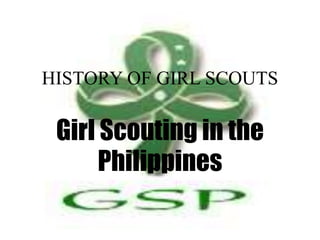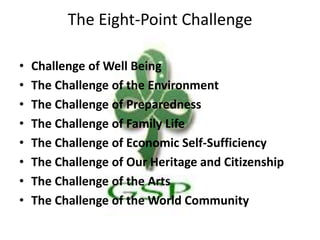History of girl scout
- 1. HISTORY OF GIRL SCOUTS Girl Scouting in the Philippines
- 2. History of the Girl Scout Movement âĒ It was started in 1906 by an Englishman and an army officer named Lord Robert Baden Powell. From that time on to the present, Scouting had a great impact on young people all over the world. Aids to Scouting, an army manual prepared by B-P (as Baden Powell was fondly called) was the first guide for Scouting activities. This consisted of tests and games of character and intelligence, physical health and endurance. B-P originally intended the manual to help his soldiers to have self-reliance, confidence and discretion through challenges and games in small groups. He called these groups PATROL. Later, the Manual became "Scouting for Boys." It grew out of the personal, exciting experiences of B-P. It established the basic structure, the Promise and Law and the Patrol System.
- 3. âĒ To practice the theories in this manual, B-P held an experimental camp at the Brownsea Island, off the coast of Great Britain. This was from July 19 - August 8, 1907. This experiment was a success. In 1908, educators hailed BP's Scouting theories as a "revolution in education methods, a new way in character training." âĒ The rest is history. âĒ Scouting spread widely and found its way to other lands.
- 4. What about the Girl Scouts? How did they come into the picture? âĒ In 1909 at the memorable Crystal Palace rally of the Boy Scouts of England, a group of uniformed, self-styled Girl Scouts came out in the open and voiced their appeal to B-P to form a similar movement for girls. B-P gave in to their clamor. He engaged his sister Agnes to help him put a movement for girls. Thus, in May, 1910, Agnes Baden-Powell became the first president of the Girl Guides.
- 5. Three women, in so far as the Girl Scouts of the Philippines is concerned, had shaped and contributed greatly to the Girl Scouting/Girl Guiding world. âĒ LADY OLAVE BADEN POWELL âĒ JULIETTE GORDON-LOW âĒ JOSEFA LLANES-ESCODA
- 6. LADY OLAVE BADEN âĒ LADY OLAVE BADEN POWELL, formerly Olave St. Claire Soames, came quietly into the movement when she married B-P eight months after a whirlwind shipboard romance while on cruise to the West Indies with her father. There she met Baden Powell and had since been actively involved in the movement in 1916 when she was appointed Country Commissioner for Sussex and later as Chief Commissioner. âĒ In 1930, the World Bureau conferred on her the title of World Chief Guide, apposition she held up to the time of her death in 1977. âĒ Lady Olave visited the Philippines twice. The first time was in March 25-27, 1958 as part of her travel itinerary in Asia and the second was on October 11, 1966 during the Closing Ceremonies of the GSP's 25th anniversary held at the Luneta Grandstand. She conveyed her warm affection and pleasant thoughts to the Filipino Girl Scouts during these visits.
- 7. JULIETTE GORDON-LOW âĒ JULIETTE GORDON-LOW, "Daisy", a woman of means from Savannah, Georgia and widow of an Englishman named William Low, met Lord B-P who interested her in the Scouting program. âĒ From childhood she had been fondly called "Daisy" like a beautiful attractive Sunshiny Flower. âĒ Baden-Powell's visit to Daisy in Scotland in 1911 inspired her to organize a Scottish Girl Guide troop. They had fun learning knots, flag history, Girl Guide Laws, knitting, cooking, first-aid, map reading and signaling. Daisy helped them learn skills for earning a living such as raising chicken and spinning. She started other Girl Guide troops in London before sailing to America to begin the first American Girl guide troop on March 21, 1912.
- 8. JULIETTE GORDON-LOW âĒ Her first 18 girls made their own dark blue uniforms with light blue ties like the British Girl Guides. They also made their own badges. They learned the Girl Guide Law, played games, went on nature hikes, did bird-watching and kept bird books. They had inter-troop basketball and a summer camp. âĒ Daisy had many talents to share. She could write, draw and sculpt. She loved tennis, horseback riding and the out-of-doors. Although she lost her hearing in midlife, she was friendly and kind and was the life of the party wherever she went. âĒ Daisy changed the name of American Girl Guides to Girl Scouts in 1913, and their uniform from blue to khaki ("which didn't show the dirt as much").
- 9. JOSEFA LLANES-ESCODA âĒ JOSEFA LLANES-ESCODA was the third woman in the triad. She was a well- known and respected social worker and civic leader from Dingras, Ilocos Norte. She had worked very hard to uplift the condition of needy and disadvantaged people. âĒ Because of the historical and political links of the Philippines with the United States, Scouting found its way to our shores. âĒ As early as 1918, lone troops were found to be in existence in the islands. Some of the early troops were organized in Davao (1918), Capiz (1926), the Mountain Province, Manila (1939) and other places. Generally, American missionaries and servicemen and other concerned members of the American communities were said to have started these troops. All these early troops, however, were registered directly with the GSUSA. âĒ Two women, Pilar Hidalgo-Lim, then President of the National Federation of Women's Clubs (NFWC) and its Executive Secretary, Josefa Llaïŋ―es Escoda, spearheaded the organization of the GSP. They asked the help of the BSP, believing that " the youth of the Philippines was not being completely served if there was only a Boy Scout organization; that there should also be a Girl Scout Movement."
- 10. JOSEFA LLANES-ESCODA âĒ Through the GSP, Mrs. Escoda was sent for Girl Scout training in 1939 to the USA and Great Britain. âĒ Upon her return to the Philippines, Mrs. Escoda set up the GSP with the help of civic-minded citizens and supporters. âĒ On May 26, 1940, the GSP was chartered as a national organization under Commonwealth Act. No. 542. âĒ In 1946, at the 11th World Conference held at Evian, France, GSP was accepted by the World Association of Girl Guides and Girl Scouts (WAGGGS) as a tenderfoot member. âĒ On August 13-23, 1948, GSP became a full member at the 12th World Conference held in Cooperstown, New York. âĒ From a membership of 3,000, the GSP increased tremendously to more than one and a half million. The organization had observed its Golden Jubilee in 1990 and is moving on fast to greater heights.
- 11. The Girl Scout of the Philippines Program âĒ The Girl Scouting Program is the action plan covering the whole Girl Scouting environment of fun, adventure and challenges where girls working alone or in small groups live the Girl Scout Promise in a democratic framework and develop themselves in self-reliance, self- esteem and service with the guidance of able and caring adults.
- 12. âĒ Characteristics of the Girl Scouting Program âĒ General Characteristics of the Girl Scouting Program âĒ Characteristics of the Girl Scouts of the Philippines âĒ The Girl Scout Promise and Law âĒ Patrol System âĒ Badgework âĒ Out-of-Doors âĒ International Friendship âĒ The Girl Scout Uniform âĒ Special Programs âĒ Capture the Girl Scout Spirit âĒ What is Girl Scouting? âĒ Organization âĒ Ways of Work âĒ Program
- 13. The Eight-Point Challenge âĒ Challenge of Well Being âĒ The Challenge of the Environment âĒ The Challenge of Preparedness âĒ The Challenge of Family Life âĒ The Challenge of Economic Self-Sufficiency âĒ The Challenge of Our Heritage and Citizenship âĒ The Challenge of the Arts âĒ The Challenge of the World Community
- 14. Thank You and God Bless!!! Tita Menelyn Mae L. Malay














